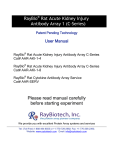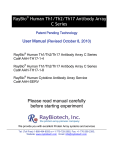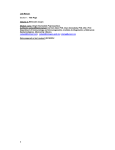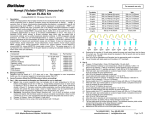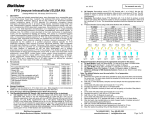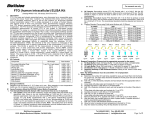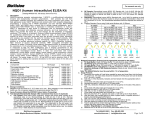Download User Manual - RayBiotech, Inc.
Transcript
RayBio® E-Series Quantitative Obesity Antibody Array 1 For Human, Mouse & Rat User Manual QEA-ADI-E1-4 QEA-ADI-E1-8 For Simultaneous Detection of 10 Obesity-related Markers (Quantitative) PLEASE READ MANUAL CAREFULLY BEFORE STARTING EXPERIMENT We Provide You with Excellent Protein Array Systems and Services Tel :( Toll Free) 1-888-494-8555 or 770-729-2992; Fax: 1-888-547-0580 Website: www.raybiotech.com Email: [email protected] RayBiotech, Inc. RayBio® Competition-based Obesity Antibody Array 1 TABLE OF CONTENTS I. Introduction……..……………………………… 2 II. Principle of the Assay………………………… 4 III. Materials……………………………………….. 6 a. Additional Materials Required……………. 6 Helpful Tips and General Considerations ….. 7 a. Preparation and Storage of Samples…... 7 b. Handling Array Membranes……………... 10 c. Incubations and Washes…………………. 10 d. Chemiluminescent Detection………….. … 11 V. Protocol………………………………………….. 12 IV. VI. a. Preparation of Reagents & Samples……. 12 b. Blocking and Incubations…………………. 13 c. Chemiluminescent Detection…………….. 14 Array Map……………………………………….. 15 VII. Data Analysis……………………………............ 16 a. Obtaining Densitometry Data……………… 16 b. Background Subtraction…………………… 17 c. Normalization of Array Data……………….. 18 d. Calculation of Percent Competition……….. 18 VIII. Troubleshooting Guide………………………….. 23 IX. Reference List……………………………………. 24 1 ® RayBio E-Series Quantitative Obesity Antibody Array 1 I. Introduction Obesity is a chronic disease that has become a major health problem in most industrialized countries because of its high prevalence, associated illnesses, and economic impact. Obesity is a major risk factor for numerous diseases including hypertension, dyslipidemia, insulin resistance, and metabolic syndrome. At least 2.8 million adults worldwide die each year as a result of being overweight or obese. Recent studies have shown that adipose tissue can no longer considered as an inert energy storage organ, but is emerging as an active participant in regulation of physiological and pathologic processes, including immunity and inflammation. Adipokines are proteins or peptides produced and secreted by adipocytes, forming complex endocrine, paracrine, autocrine or juxtacrine cross-talk, and involved in the pathophysiologies of insulin resistance, diabetes mellitus, hypertension, metabolic syndrome, rheumatoid arthritis, endothelial dysfunction, and a host of other obesity-related diseases. Many adipokines act as cytokines as well, driving inflammatory and other immune functions. The E-Series Competition-based Obesity Antibody Array detects 10 important adipokines: visfatin, nesfatin, resistin, retinol binding protein-4, atrial natriuretic peptide, C-peptide, gastrin, inhibin B, neuropeptide Y, and vaspin. Over the past decade, RayBiotech has developed a series of novel protein array systems for high-throughput screening and quantification of multiple proteins. These techniques have had significant impact on biomedical research, including protein expression profiling, determination of protein function, and particularly the discovery and development of drugs and biomarkers. Our technologies include the biotin label-based antibody array (L-Series) and the sandwich ELISAbased array systems (C-Series, G-Series, and Quantibody®). Recent technological advancements at RayBiotech have broadened the options for protein detection even further. The Competition-based Antibody Array (“E-Series”) is a novel array platform based on the same competitive immunoassay principle used in RayBiotech’s single-target EIA kits; here, the target proteins and a cocktail of biotin- 2 ® RayBio E-Series Quantitative Obesity Antibody Array 1 labeled peptides competitively bind to an array of capture antibodies on a solid support. The E-Series array has important advantages over other array platforms. First, it enables the detection of unique biomarkers or peptides for which no antibody pair exists, or for which antibody pairs cannot be developed. Like the EIA kits, this array requires only a single antibody and a biotinylated peptide competitor for signal output. Second, the E-Series is a broad-species array validated for rat, mouse, and human samples, with expected reactivity with many other species. Another key feature of the E-Series is that, unlike the LSeries, it can be either quantitative or semi-quantitative. If quantitative data is desired, a cocktail of peptides (derived from the target protein sequences) serves as the standard mix for derivation of standard curves. All 10 adipokines can be detected at pg/ml to ng/ml levels with inter- and intra-assay CV’s of less than 20%. 3 ® RayBio E-Series Quantitative Obesity Antibody Array 1 II. Principle of the Assay With the RayBio® Competition-based Obesity Antibody Array kit, researchers can now simultaneously detect semi-quantitative levels of 10 adipokines in serum, plasma, cell culture media and cell lysates. By monitoring the changes in protein levels in different experimental model systems, researchers can study pathway activation without spending excess time and effort in performing immunoprecipitation and/or Western Blotting. The E-Series array adopts the principle of competition-based enzyme immunoassay (cEIA) wherein a labeled target and the endogenous target competitively bind to the antibody on the matrix. In this platform, 10 different anti-adipokine antibodies are spotted onto membranes in an array format. A cocktail of 10 biotin-labeled adipokine peptides is spiked into the samples, and the labeled and unlabeled targets competitively bind to their corresponding antibodies. After a wash step, streptavidin-horseradish peroxidase (SA-HRP) is incubated with the arrays, which interacts only with the biotin-labeled adipokines bound to the target antibodies. The chemiluminescent array signals are directly proportional to the amount of biotinylated peptide-SA-HRP complex and inversely proportional to the amount of adipokines in the samples. 4 ® RayBio E-Series Quantitative Obesity Antibody Array 1 How It Works 5 ® RayBio E-Series Quantitative Obesity Antibody Array 1 III. Materials Provided ITEM DESCRIPTION QEA-ADI-E1-4 QEA-ADI-EI-8 12 membranes for 4 samples 3 vials 16 membranes for 8 samples 4 vials 0103004-ADIE1S 0103004-H 0103004-B 0103004-W RayBio® E-Series Array Membranes* Biotinylated Peptide Cocktail Standard Peptide Cocktail 2 vials 2 vials 500X HRP-Streptavidin 1X Blocking Buffer 20X Wash Buffer I† 1 vial (50µl) 2 vials (25 ml/ea) 1 vials (20 ml) 2 vials (25 ml/ea) 1 vials (20 ml) 0103004-W 20X Wash Buffer II† 1 vials (20 ml) 1 vials (20 ml) 0103004-L 0103004-D 2X Cell Lysis Buffer 1X Detection Buffer C† 1 vials (5 ml) 2 vials (2.5 ml/ea) QEA-ADI-E1M 0103002-ADI-E1 0103004-D 1X Detection Buffer D† 2 vials (2.5 ml/ea) 0103004-T 8-Well Incubation Tray 1 tray Other Kit Components: Plastic sheets, Manual, Packing list * Packs contains 2 or 4 arrays each † Wash Buffers and Detection Buffers are sold as Sets A. Additional Materials Required • Small plastic boxes or containers • Orbital Shaker • Plastic sheet protector or Saran Wrap • A chemiluminescent blot documentation system (such as UVP’s ChemiDoc-It® or EpiChem II Benchtop Darkroom), Xray film and a suitable film processor, or another chemiluminescent detection system. Upon receipt, the entire kit should be stored at –20 °C and used within 6 months from the date of shipment. After initial use, Blocking Buffer, 20X Wash Buffer I, 20X Wash Buffer II and HRP-conjugated streptavidin can be stored at 4°C for up to 3 months. After reconstitution, biotinylated peptide cocktail should be aliquotted and stored at -20 °C for up to 1 month. Array membranes should be stored at –20 °C. 6 ® RayBio E-Series Quantitative Obesity Antibody Array 1 IV. Helpful Tips and General Considerations A. Preparation and Storage of Samples 1. General Considerations: • Freeze samples as soon as possible after collection. • Avoid multiple freeze-thaw cycles. If possible, subaliquot your samples prior to initial storage. • Spin samples hard (5-10 minutes at 10K to 15K RPM) immediately prior to incubation of samples with array. • Optimal sample concentrations may need to be determined empirically based on the signal intensities of spots and background signals obtained with each sample. • If spot intensities are weak, increase sample concentration in subsequent experiments. • If background or spot intensities are too strong, decrease sample concentration in subsequent experiments. • Most samples will not need to be concentrated. If concentration is required, we recommend using a spincolumn concentrator with a chilled centrifuge. • Unless otherwise noted, dilute all samples using the same dilution factor in 1X Blocking Buffer. 2. Recommended Sample Volumes and Dilution Factors NOTE: All sample dilutions should be made using the Blocking Buffer provided in this kit. For all sample types, final sample volume should equal 1 ml per membrane. • Cell Cultured Media: 2-fold dilution • Serum & Plasma: 2-fold to 4-fold dilution • Cell and Tissue Lysates: 2-fold to 4-fold to equal concentrations of total protein in lysate. Optimal 7 ® RayBio E-Series Quantitative Obesity Antibody Array 1 sample concentration of cell and tissue lysates should be determined empirically. o For more details, please see Section IV.A.4 (Cell and Tissue Lysates/Homogenates). 3. Preparing Serum/Plasma: • Prepare samples according to established protocols or collection tube manufacturer’s instructions. Subaliquot into plastic tubes. Store at –20°C or –80°C. • We do not recommend comparing results between serum and plasma samples or between plasma prepared using different anticoagulants. • If possible, avoid testing hemolyzed serum or plasma, as these samples may generate anomalous protein expression patterns and/or high background signals. 4. Preparing Cell-Cultured Media: • Expression of proteins in cell culture may depend on many variables, including cell type, starting cell number, media composition and growth conditions. • To start, we recommend seeding ≥1 x 106 cells in a 100 mm culture dish. However, you should consult the scientific literature for tips on how to cultivate your particular cell type. • Cell type and experimental protocols can profoundly influence protein expression. Please consult the scientific literature for details on the effectiveness of various treatments to elicit a desired response, optimal timeframes for growing cells prior to treatment, optimal concentrations and exposure times for treatments and the timing of sample collection. • Serum-containing media rarely produce a baseline signal response with this product. Nevertheless, an 8 ® RayBio E-Series Quantitative Obesity Antibody Array 1 ideal experimental design would be to test uncultured media as a sample “blank” to assess baseline signal responses. 5. Preparing Cell and Tissue Lysates/Homogenates: • IMPORTANT: Lysate sample volumes required must be determined empirically and will depend upon the total protein concentration of each lysate and the intensity of background signals for each sample. o You must determine the total protein concentration of each lysate/homogenate. We recommend using the BCA method (available from Pierce), as it is insensitive to detergents commonly found in lysis buffers. o Minimum Recommended Total Lysate Protein Concentration (prior to sample dilution) = 1.0 µg/µl o Minimum Recommended Dilution of Lysates (prior to sample incubation): 2-fold to 4 fold with 1X Blocking Buffer. Dilute all lysate samples to the same final concentration of total lysate protein in 1X Blocking Buffer to 1 ml final volume. o For your first experiment, we recommend using 400-500 µg of total protein in 1 ml of 1X Blocking Buffer (final volume) for each array membrane. o Optimal amounts of total lysate protein may range from 50-1000 µg per array membrane. Based upon the signal intensities of background and spots obtained with each sample, you may need to increase or decrease the volume of lysate used in subsequent experiments. • We recommend preparing cell or tissue lysates using 2X RayBio® Cell Lysis Buffer (Cat# 0103004-L). Be sure to properly dilute RayBio® Cell Lysis Buffer (1:1 with deionized H2O) before use. • Other lysis buffers can be used if they are nondenaturing, non-reducing, total salt concentration ≤700 9 ® RayBio E-Series Quantitative Obesity Antibody Array 1 • • • • mM), contain ≤2% total detergent (v/v) and are free of sodium azide (NaN3). We strongly recommend adding protease inhibitors to your cell lysis buffer. Any broad-spectrum protease inhibitor cocktail intended for preparation of mammalian cell/tissue lysates should be sufficient, but please consult the scientific literature before deciding upon the exact composition of cocktail to use. Optimal protocols for mechanical disruption vary for different cell and tissue types. Please consult the scientific literature for examples of successful detection of proteins using ELISA or multiplex ELISA techniques in lysates made from cell or tissue samples similar to yours. BEWARE! Sonication can quickly heat volumes of 1 ml or less and denature proteins in your samples! After extraction, clarify your lysates by centrifugation and save the supernatant for your experiment. Preparing sub-aliquots is strongly recommended. B. Handling Array Membranes • The printed side of each array membrane is marked with a dash (-) or Array number in the upper left corner. • Always use forceps to handle membranes, and grip the membranes by the edges only. Flat-tipped forceps are best for handling membranes. • Never allow array membranes to dry during experiments. • Avoid touching array membrane by hand, tips or any sharp tools. C. Incubations and Washes • Perform all incubation and wash steps under gentle rotation or rocking motion (~1 to 2 cycles/sec) to ensure complete and even solution coverage as well as to 10 ® RayBio E-Series Quantitative Obesity Antibody Array 1 • • • • avoid foaming or bubbles from appearing on the membrane surface. All washes and incubations (except for detection buffers incubation step) should be performed using the 8-Well Incubation Tray provided in the kit. Cover the 8-Well Incubation Tray with the lid for all incubation steps to avoid evaporation. Completely cover the membranes with sample or reagent during each incubation. Avoid forceful pipetting directly onto the membrane; instead gently pipet in a corner of each well. The sample and HRP-Streptavidin incubation steps may be performed overnight at 4°C. Overnight incubations are the most effective method of increasing spot intensities but may also increase background noise. D. Chemiluminescent Detection • Trying multiple exposure times is recommended to obtain optimum results. Anywhere from a few seconds to 10 minutes is common; 30 seconds to 1 minute is suitable for most samples. • If the signals are too weak, increase exposure time (e.g. 2-10 mins). If the signals are too strong, reduce exposure time (e.g. 3-30 seconds). • Blot documentation systems that use CCD cameras are ideal for imaging RayBio® array membranes. They can easily be programmed to take multiple exposures, and the dynamic range of these detectors tends to be 2-3 orders of magnitude greater than that of X-ray film or and much more sensitive to chemiluminescence than phosphorimaging systems. 11 ® RayBio E-Series Quantitative Obesity Antibody Array 1 V. Protocol A. Preparation of Reagents and Samples NOTE: Keep all reagents on ice during preparation. Reagents should only be used in their 1X working concentration. 1. Blocking buffer is supplied at 1X concentration. 2. Wash buffers I and II are supplied at a 20X concentration. a) Dilute each wash buffer to 1X with distilled or deionized water. b) 1X Wash Buffers can be stored at 4°C for up to 1 month. 3. Biotin-Peptide Cocktail a). This reagent will be used to spike all standards and samples (except the blank). b). Briefly centrifuge each vial prior to reconstitution. c). Pipet 42 µl of 1X blocking buffer into the vial and mix gently by pipetting up and down. The resulting solution is 100X, and is enough to spike 4 samples (i.e. 4 membranes). Reconstitute additional vials of biotin-peptide cocktail if needed (1 vial per 4 membranes). d). After reconstitution, the 100X biotin-peptide cocktail should be used right away; we do not recommend storing for future use. 4. Standard Peptide Cocktail a). Briefly centrifuge each vial prior to reconstitution. b). Pipet 11 µl of 1X blocking buffer into the vial and mix gently by pipetting up and down. The resulting solution is enough for 1 standard curve. c). After reconstitution, the standard cocktail should be used right away; we do not recommend storing for future use. 12 ® RayBio E-Series Quantitative Obesity Antibody Array 1 HRP-Conjugated Streptavidin is supplied at a 500X concentration. a). Mix the 500X HRP-Conjugated Streptavidin vial well before use as precipitate may form during storage. b). Dilute HRP-Conjugated Streptavidin to 1X with 1X Blocking Buffer. c). 1X HRP-Conjugated Streptavidin can be stored for 2-3 days at 4°C. Detection Buffers C & D are supplied ready to use. Once thawed, these buffers may be stored at 4°C for up to 3 months. Sample Preparation: The recommended working volume for all samples is 1 ml. a). Use blocking buffer to dilute samples. Please refer to section IV (Helpful Tips and General Considerations) for sample dilution recommendations. b). Prior to loading onto the membranes, it is very important that every sample be spiked with 100X biotin-peptide cocktail (prepared in step 3). Thus, 10 µl of cocktail should be added per 1000 µl of sample (after dilution). EXAMPLE: when making a 2-fold sample dilution, use 500 µl of sample, 490 µl of blocking buffer, and 10 µl of 100X biotin-peptide cocktail. c). If you plan to use undiluted samples, you must still add 100X biotin-peptide cocktail prior to loading onto the membrane. 5. 6. 7. 8. Standard Preparation: Label 6 microtubes as follows: SD1, SD2, SD3, SD4, SD5, and SD0. a). Pipet 55 µl of 100X biotin-peptide cocktail (prepared in step 3) into 5445 µl of blocking buffer and mix thoroughly; this solution is 1X biotin-peptide cocktail. Transfer 900 µl of 1X biotin-peptide cocktail into each tube, except for the SD1 (leave this one empty). Briefly centrifuge the vial of standard peptide cocktail 13 ® RayBio E-Series Quantitative Obesity Antibody Array 1 (prepared in step 4) before opening. Into the tube labeled SD1, pipet 10 µl of standard and 990 µl of biotin-peptide cocktail. Mix thoroughly. This solution serves as the first standard (SD1). b). To make the SD2 standard, pipet 100 µl of SD1 into the tube labeled SD2. Mix thoroughly. c). Repeat this step with each successive concentration, preparing a dilution series as shown in the illustration below. Each time, mix 900 µl of 1X biotin-peptide cocktail and 100 µl of the prior concentration until SD5 is reached. Mix each tube thoroughly before the next transfer. d). The final tube serves as the zero standard (or total binding). B. Blocking and Incubations NOTE: Prepare all reagents and samples immediately prior to use. All incubations and washes must be performed under gentle rotation/rocking. 1. Place each membrane printed side up (see Section III.B) into a well of the 8-Well Incubation Tray (top left corner marked with “-”). 2. To block, pipet 2 ml of 1X blocking buffer into each well and incubate for 30 minutes at room temperature (RT). 14 ® RayBio E-Series Quantitative Obesity Antibody Array 1 3. Aspirate 1X blocking buffer from each well. 4. Pipet 1 ml of prepared samples and standards into each well and cover with lid. Incubate for 1.5 - 2 hours at RT or overnight at 4°C. One membrane must be used for a blank (blocking buffer only; no peptide or sample). The standard curve requires 6 membranes, and the remaining membranes may be used for samples. 5. Aspirate samples from each well. 6. Wash Buffer I Wash: Pipet 2 ml of 1X Wash Buffer I into each well and incubate for 5 minutes at RT. Repeat this 2 more times for a total of 3 washes using fresh buffer and aspirating each time. 7. Wash Buffer II Wash: Pipet 2 ml of 1X Wash Buffer II into each well and incubate for 5 minutes at RT. Repeat this 1 more time for a total of 2 washes using fresh buffer and aspirating each time. 8. Pipet 1.5 ml of 1X HRP-Conjugated Streptavidin into each well and incubate for 2 hours at RT. 9. Aspirate 1X HRP-Conjugated Streptavidin from each well. 10. Wash membranes as directed in Steps 6 and 7. C. Chemiluminescent Detection Do not let the membrane dry out during detection. The detection process must be completed within 40 minutes without stopping. 1. Transfer and place each membrane printed side up onto a sheet of chromatography paper, tissue paper, or blotting paper lying on a flat surface, such as a benchtop. 2. Remove any excess wash buffer by blotting the membrane edges with another piece of chromatography, blotting, or tissue paper. 3. Transfer and place each membrane printed side up onto a plastic sheet (provided) lying on a flat surface. 15 ® RayBio E-Series Quantitative Obesity Antibody Array 1 4. 5. Into a single, clean tube, pipet equal volumes (1:1) of Detection Buffer C and Detection Buffer D. Mix well. Gently pipet 500 µl of the Detection Buffers mixture onto each membrane (e.g., 500 µl = 250 µl of Detection Buffer C and 250 µl of Detection Buffer D) and incubate for 2 minutes at RT (do not rock or shake). Immediately afterwards, proceed to Step 6. NOTE: Exposure should ideally start within 5 minutes after finishing Step 5 and completed within 20 minutes, as chemiluminescent signals will fade over time. 6. Place another plastic sheet on top by starting at one end and gently “rolling” the flexible plastic across the surface to the opposite end to smooth out any air bubbles. The membranes should now be sandwiched between two plastic sheets. NOTE: Avoid sliding the plastic sheet along the membranes’ printed surface. 7. If using a CCD camera (recommended), transfer the sandwiched membranes to the imaging system and expose. (See tips for obtaining array images in Section III.D). NOTE: If using X-ray film (such as Kodak’s X-Omat™ AR film), remove the top plastic sheet covering the printed side so that the membranes can be directly exposed to the film. 8. Try multiple exposures to obtain an image with low background and strong positive control signal spots that do not bleed into one another. Typical exposure times are between few seconds to 2 minutes. 9. Storing Membranes: without direct pressure, gently sandwich the membranes between 2 plastic sheets (if not already), tape the sheets together or wrap in plastic wrap to secure them, and store at ≤ -20oC. 16 ® RayBio E-Series Quantitative Obesity Antibody Array 1 VI. Competition-based Quantitative Obesity Array ESeries 1: Map A B C D 1 2 3 4 5 6 7 8 POS POS NEG NEG VISFATIN NESFATIN NPY NEG POS POS NEG NEG VISFATIN NESFATIN NPY NEG VASPIN RBP4 RESISTIN ANP C-PEPTIDE GASTRIN INHIBIN B POS VASPIN RBP4 RESISTIN ANP C-PEPTIDE GASTRIN INHIBIN B POS 17 ® RayBio E-Series Quantitative Obesity Antibody Array 1 VII. Data Analysis The preceding figure presents typical images obtained with RayBio® Competition-based Obesity Array I. These membranes were probed with conditioned media from two different cell lines. Membranes were exposed to Kodak X-Omat® film at room temperature for 1 minute. Note the strong signals of the Positive Control spots, provided by biotin-conjugated IgG printed directly onto the array membrane in the upper-left and lower-right corners. These Positive Control spots are useful for proper orientation of the array image. Also note that, unlike other RayBio® or Quantibody® arrays, the signal densities are not proportional to the target protein concentration; instead, the spot signals are high when the protein concentration is low (and vice versa). An antibody’s affinity to its target varies significantly from one antibody to another. The intensity detected on the array with each antibody depends on this affinity; therefore, signal intensity comparison can be performed only within the same antibody/antigen system and not between different antibodies. A. Obtaining Densitometry Data Visual comparison of array images may be sufficient to see differences in relative protein expression. However, most researchers will want to perform numerical comparisons of the signal intensities (or more precisely, signal densities), using 2-D densitometry. Gel/Blot 18 ® RayBio E-Series Quantitative Obesity Antibody Array 1 documentation systems and other chemiluminescent or phosphorescent detection systems are usually sold as a package with compatible densitometry software. To obtain densitometry data from an X-ray film, one must first scan the film to obtain a digitized image using an ordinary office scanner with resolution of 300 dpi or greater. Any densitometry software should be sufficient to obtain spot signal densities from your scanned images. One such software program, ImageJ, is available for free from the NIH (for more info, visit http://rsbweb.nih.gov/ij/). We suggest using the following guidelines densitometry data from our array images: when extracting • For each array membrane, identify a single exposure that the exhibits reasonably low background signal intensity and strong Positive Control signals that do not “bleed” into one another. Exposure time does not need to be identical for each array, but Positive Control signals on each array image should have similar intensities. • Measure the density of each spot using a circle that is roughly the size of one of the largest spots. Be sure to use the same circle (area and shape) for measuring the signal densities on every array for which you wish to compare the results. • For each spot, use the summed signal density across the entire circle (ie, total signal density per unit area), not the mean or median value. Once you have obtained the raw numerical densitometry data, you should subtract the background and normalize to the Positive Control signals before proceeding to analysis. B. Background Subtraction On each array, several “Negative Control” (NEG) spots are included. Negative Control spots are printed with antibody diluent buffer. Thus, 19 ® RayBio E-Series Quantitative Obesity Antibody Array 1 the signal intensities of the Negative Controls represent the background plus non-specific binding to the printed spots. For each membrane, we recommend subtracting the mean of 4 or more Negative Control spots from every other spot on that membrane. The resulting numbers represent the background corrected spot values. C. Normalization of Array Data The amount of biotin-conjugated IgG protein printed for each Positive Control spot is consistent from array to array. As such, the intensity of these Positive Control signals can be used to normalize signal responses for comparison of results across multiple arrays, much like housekeeping genes and proteins are used to normalize results of PCR gels and Western Blots, respectively. To normalize array data, one array must be designated as the "reference" to which the other arrays are normalized. The choice of reference array is arbitrary. For example, in our Analysis Tool Software, the array represented by data entered in the first column on the left of each worksheet is the default “reference array.” The normalized values can be calculated as follows: X(Ny) = X(y) * P1/P(y) Where: P1 = mean signal density of Positive Control spots on reference array P(y) = mean signal density of Positive Control spots on Array "y" X(y) = mean signal density for spot "X" on Array for sample "y" X(Ny) = normalized signal intensity for spot "X" on Array "y" D. Calculation of Percent Competition: After normalization to Positive Control signal intensities, you must then subtract the “baseline signal response”. The baseline signals are represented by the BLANK membrane, which was incubated with Blocking Buffer only. Simply subtract the normalized, background20 ® RayBio E-Series Quantitative Obesity Antibody Array 1 subtracted signal intensities of the BLANK membrane from the corresponding spots on the other membranes. For example, if the signal intensity of Protein X on Membrane y is 1,000 and the signal intensity of Protein X on the BLANK Membrane is 100, then the final value for Protein X on Membrane y would be 900. The percent signal intensity and percent competition can be calculated by the following formula: [X(Ny) – BLANK] / [X(Ntb) – BLANK] X 100 = % Signal Intensity Where: X(Ny) = normalized signal of a spot on the sample membrane X(Ntb) = normalized signal of a spot on the total binding membrane NOTE: If the BLANK signals have already been subtracted, do not subtract them again, simply use X(Ny)/X(Ntb) X 100 = % Signal Intensity. Finally, the Percent Competition can be calculated by the following formula: 100% - % Signal Intensity = % Competition 21 ® RayBio E-Series Quantitative Obesity Antibody Array 1 The tables below indicate the average signal intensities for various concentrations of a standard non-labeled peptide. Please note: these data should be used only to aid in estimation of fold changes in target protein levels; they are not intended to be used as standard curves for quantitative protein determination. For accurate calculation of target concentrations, we recommend the Quantitative E-Series Array kit (QEA-ADI-E1). Percent Signal Intensity ng/ml Visfatin Nesfatin NPY RBP4 Resistin C-Peptide 1000 9 1 3 6 3 2 100 23 30 27 44 21 19 10 73 67 88 95 94 69 1 95 81 92 100 107 102 pg/ml Vaspin ANP Gastrin Inhibin B 1000 2 2 7 4 100 29 11 37 47 Percent Signal Intensity 10 96 67 63 94 1 119 109 85 100 The RayBio® Analysis Tool software is available for use with data obtained using RayBio® E-Series Antibody Arrays. Copy and paste your signal intensity data into the “Aligning Data” worksheet, and it will assist in compiling and organizing your data, as well as automatically subtracting background signals and normalizing to the Positive Controls. To order the Analysis Tool, please contact us at +1-888494-8555 or [email protected] for more information. 22 ® RayBio E-Series Quantitative Obesity Antibody Array 1 Fig 1. Adipokine expression profiling in serum samples using RayBio® Competition-based Obesity Antibody Array E1. Diluted serum samples from human (HS), mouse (MS) and rat (RS) were used to profile adipokine expression profiling with the E-Series Obesity Array 1. The signals were detected by a chemiluminescence imaging device. Percentages of competition for each adipokine are also shown. Blank Total Binding Human Serum Mouse Serum Visfatin Nesfatin Neuropeptide Y Vaspin RBP-4 Resistin ANP C-Peptide Gastrin Inhibin-B Rat Serum Percentage Competition Human Mouse Rat 80.04 55.17 68.45 93.36 48.71 93.28 84.78 75.56 90.12 90.41 90.48 87.93 90.63 91.31 88.5 91.65 93.29 92.85 7.85 20.4 24.1 85.18 79.24 82.36 93.91 85.93 83.97 77.93 72.72 73.53 23 ® RayBio E-Series Quantitative Obesity Antibody Array 1 Fig 2. Cross-reactivity tests for the RayBio® Competition-based Obesity Antibody Array E1. After blocking, each membrane was incubated with both biotinpeptide cocktail and 1000 ng/ml single unlabeled peptide (one for each of the 10 array targets). All 10 peptides show highly specific signal competition on the array. POS VIS VASP CPE NES RBP GAS NPY RES INB ANP CTRL 24 ® RayBio E-Series Quantitative Obesity Antibody Array 1 VIII. Troubleshooting Guide Problem Weak or no signal Cause Recommendation Taking too much time during detection Film detector does not work properly Detection process must be completed within 40 minutes Fix film developer Inadequate mixing of streptavidin-HRP Mix streptavidin-HRP well before use since precipitation may form during storage. Sample is too concentrated Reduce sample concentration. Reduce blocking by diluting 1X blocking buffer Increase streptavidin-HRP concentration Other Uneven signal Increase bionylated peptide cocktail concentration. Expose film overnight to detect weak signals. Bubbles forming during Remove bubbles during incubation. incubation steps Membrane is not evenly Keep membranes completely submerged covered by buffer in solution during incubations. Film is exposed too long Reduce exposure time High background Membrane dries out during experiment Keep membranes completely submerged in solution during incubations. 25 ® RayBio E-Series Quantitative Obesity Antibody Array 1 IX. Reference List 1. Jiang W, Chen Y, Wu L, Jones V, Zhang Y, Huang R, Huang RP (2012) “A novel competition-based antibody array technology as a potential platform for cancer biomarker discovery”, One-hundredand-three Annual Meeting of American Association for Cancer Research, Chicago, 2012. Related Products We also offer over 30 EIA kits for validation of your E-Series array results. Please visit our website for more information (www.raybiotech.com). RayBiotech, Inc., the protein array pioneer company, strives to research and develop new products to meet demands of the biomedical community. RayBio® patent-pending technology allows detection of over 500 cytokines, chemokines and other proteins in a single experiment. Our format is simple, sensitive, reliable and cost effective. Products include: Cytokine Arrays, Chemokine Arrays, ELISA kits, EIA kits, Phosphotyrosine kits, Recombinant Proteins, Antibodies, and custom services. 26 ® RayBio E-Series Quantitative Obesity Antibody Array 1 This product is for research use only ©2013 RayBiotech, Inc. 27 ® RayBio E-Series Quantitative Obesity Antibody Array 1





























